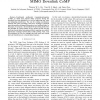VTC
2010
IEEE
13 years 10 months ago
2010
IEEE
— In this paper, a 2-dimensional water-filling (2D-WF) based transmit weight that maximizes the channel capacity is theoretically derived for the downlink transmit diversity of s...
VTC
2010
IEEE
13 years 10 months ago
2010
IEEE
VTC
2010
IEEE
13 years 10 months ago
2010
IEEE
—We derive an adaptive power control method for a collaborative network utilizing partner selection that aims to minimize the frame error rate (FER). We model a decodeand-forward...
VTC
2010
IEEE
13 years 10 months ago
2010
IEEE
—The performance of 802.11-based multi-channel wireless mesh networks is affected by the interference due to neighboring nodes operating on same or adjacent channels. In this pap...
VTC
2010
IEEE
13 years 10 months ago
2010
IEEE
—In this paper, we propose a distributed load balancing using association control, especially for Tactical Information Communication Networks (TICNs). We develop a scheme for eff...
VTC
2010
IEEE
13 years 10 months ago
2010
IEEE
— In this contribution, a novel Ant Colony Optimization (ACO) based Space-Time (ST) Multiuser Detection (MUD) algorithm was proposed in order to improve the Bit Error Ratio (BER)...
VTC
2010
IEEE
13 years 10 months ago
2010
IEEE
—Coordinated multi-point transmission/reception (CoMP), in which base stations (BSs) cooperate during the downlink, has been identified as a tool for improving user rates and mi...
VTC
2010
IEEE
13 years 10 months ago
2010
IEEE
—In order to evaluate the performance of new mobile network technologies, system level simulations are crucial. They aim at determining whether, and at which level predicted link...
VTC
2010
IEEE
13 years 10 months ago
2010
IEEE
Abstract—In this paper we present an overview of a vehicleto-vehicle radio channel measurement campaign at 5.6 GHz. The selected measurement scenarios are based on important safe...
VTC
2010
IEEE
13 years 10 months ago
2010
IEEE
— in this paper we address the problem of reducing the feedback for the downlink transmission in multi-carrier systems. In these systems multiple Component Carriers (CCs) are agg...

